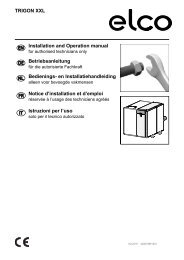Nimbus Compact M NET R32 Installation Manual UK
You also want an ePaper? Increase the reach of your titles
YUMPU automatically turns print PDFs into web optimized ePapers that Google loves.
Commissioning<br />
6.7 Temperature adjustment<br />
Simultaneously press the “Esc” and “Menu” buttons until “Insert<br />
Code” appears on the display.<br />
Turn the selector to enter the technical code (234) then press<br />
the selector to confirm; the display will show TECHNICAL<br />
AREA.<br />
Turn the selector to choose the desired item.<br />
– COMPLETE MENU<br />
Press the selector . Turn the selector to choose the desired<br />
item.<br />
4 ZONE 1 PARAMETERS<br />
4.0 SETPOINT<br />
4.0.0 T Day<br />
4.0.1 T Night<br />
4.0.2 T set Z1<br />
4.0.3 Zone frost temperature<br />
4.1 AUTOMATIC WINTER MODE<br />
4.1.0 Automatic winter mode activation [ON, OFF]<br />
Press the selector . Turn the selector to choose the desired<br />
item.<br />
0 OFF.<br />
1 ON.<br />
Press the selector to confirm.<br />
4.1.1 Automatic winter mode threshold<br />
Turn the selector and set the auto summer/winter switching<br />
delay.<br />
4.1.2 Automatic winter mode delay time<br />
Turn the selector and set the auto summer/winter switching<br />
delay.<br />
4.2 SETUP<br />
4.2.0 Zone temperature range<br />
Press the selector . Turn the selector to choose the desired<br />
item.<br />
0 Low Temp.<br />
1 High Temp.<br />
Press the selector to confirm.<br />
4.2.1 Thermoregulation<br />
Press the selector . Turn the selector to choose the desired<br />
item.<br />
0 Fix Flow T.<br />
1 Basic Thermoreg.<br />
2 Room T Only.<br />
3 Outdoor T Only.<br />
4 Room+Outdoor T.<br />
Press the selector to confirm.<br />
4.2.2 Slope<br />
Press the selector . Turn the selector and set the curve in<br />
accordance with the type of heating system.<br />
Press the selector to confirm.<br />
Low-temperature system (underfloor panels) curve between<br />
0.2 and 0.8.<br />
High-temperature system (radiators) curve between 1.0 and<br />
3.5.<br />
The checking process for the suitability of the curve requires a<br />
long period of time during which several adjustments may be<br />
necessary. When the outdoor temperature falls (winter) three<br />
conditions may arise:<br />
– The temperature of the room may fall, indicating that a<br />
steeper curve should be set.<br />
– The temperature of the room may rise, indicating that a<br />
gentler curve should be set.<br />
– The temperature of the room remains constant, indicating<br />
that the set curve is exactly right.<br />
Once you have found the curve which maintains the room<br />
temperature at a constant level, check the actual temperature<br />
value.<br />
°C 100<br />
1<br />
90<br />
80<br />
70<br />
60<br />
50<br />
40<br />
30<br />
25 20 15<br />
10 5 0 -5 -10 -15 -20°C<br />
2 3<br />
°C<br />
3.5 3.0 2.5 2.0<br />
1 Delivery temperature to the system<br />
2 Delivery value room temperature<br />
3 Outdoor T<br />
4 Low temperature<br />
5 High temperature<br />
1.5<br />
1.2<br />
1.0<br />
0.8<br />
0.6<br />
0.4<br />
0.2<br />
5<br />
4<br />
Fig. 90<br />
4.2.3 Offset<br />
Press the selector . Turn the selector and set the most suitable<br />
value. Press the selector to confirm.<br />
IMPORTANT:<br />
If the room temperature is higher than the desired value,<br />
the curve must be shifted lower. If the room temperature<br />
is too low, the curve should be shifted upwards. If the<br />
temperature of the room corresponds with the desired<br />
value, the curve is correct.<br />
58 / EN

















